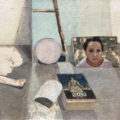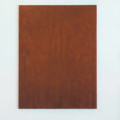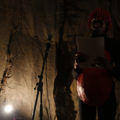Gabriel Moraes Aquino, the soil for house
The shape of the house is immediately recognizable. It is omnipresent in Gabriel Moraes Aquino’s work, an assembly of squares and triangles for the walls and roof. It is a simple and almost universal shape that can be used to mark out a space of its own, a shelter from wind and rain. In plan or volume, the artist associates through his series Lares Temporários (Temporary Homes) this familiar landmark to the earth in a primordial gesture. The ability to build a refuge with the elements at hand is at the origin of all civilizations. In London in 2018, he delimits a form of house in a park that he leaves for a few days at the mercy of the elements, wind and rain, animals passing through, leaves falling, before bringing it back into the space of a gallery. On the earth, the passage of time on more or less long scales, the marks of the last few days, the complex geological and biological process that led to the formation of humus can be read. The artist suspends by the exhibition a moment of the natural cycle, fixed with glue on a canvas, the reactions of the earth to humidity and drought act as a barometer and point to the very fragility of our habitats that are likely to crumble and collapse.

The different earth textures function as a collection through which we can read the climate and the seasons but also the actions of Man. Gabriel Moraes Aquino collects them and encloses them in wooden frames, he particularly seeks to see the imprint of Man on his environment, the trace of a step or that of a forgotten object. These paintings, entitled Para Elevar (To Grow) are not without aesthetic qualities and recall Jean Dubuffet’s Texturologies et Empreintes, but are similar to a more literal way of capturing and moving reality. After the London exhibition ended, the artist buried his installation Morada I (Home Mark I), almost as if nothing had happened. A series of photographs document the process where, on his back, he returns to that part of the park where he had found the land necessary for his refuge. It accentuates the transitional nature of its approach, which plays on poor materials, such as the reuse of parts and recycling.
Gabriel Moraes Aquino creates most of the time in situ and before arriving at the Beaux-Arts de Paris, he had no studio. After studying communication in Brazil, he designed his first projects in Rio with the Gregário collective around specific spaces. On the heights of the city, they occupied an old hotel and conducted various experiments influenced by the state art. Living in the ruined state of the building, they created a unique path called Convite aos Errantes (Invitation to Wanderers) where the visitor was alternately put at a distance and integrated into the rooms. The works, which themselves rearranged objects found on the spot, played on the idea of order and disorder. This research was important for the artist because it allowed him to develop an awareness of the environment, architectural or natural, but also and finally political. Gabriel Moraes Aquino has thus taken a very close interest in Brazilian urban planning and its excesses, expropriation, corruption and speculative constructions.

“Welcome” summarizes Brazil’s invitation to mass tourism at the 2014 Football World Cup and the 2016 Rio Olympic Games. It is also a word that Gabriel Moraes Aquino found on the doormat of a house that was going to be razed to the ground to build a modern building. The installation Oriundo da Vinda (Arising by the Arrival) is composed of all the objects that could be contained in a suitcase that the artist found in the field. Remains that could not be transported, scraps of little importance that show a shocking reality of real estate and forced displacement. In a first Desvio Consolidado (Consolidated Deviation) performance, Gabriel Moraes Aquino locked himself in a block construction, a metaphor for the speculative logic of the construction industry and its risks to the economy. He has thus continued his work on habitat and displacement to Europe where his works have become more symbolic but no less committed from an ecological or even anthropological point of view.

The house has thus returned as a symbol, an idea that can be examined head-on, turning around or passing the head inside. But it is all the more problematic as one cannot really access or inhabit it if one looks at the Refúgio de Terra (Soil Shelter) system. The constantly repeated image of the Lares Temporários (Temporary Homes) consecrates home as a sacred and allegorical space. The artist finally carries with him a model, which he declines according to his movements and the land he finds on the way. Carrego Terras (I Carry Land), the title of one of his performances, thus becomes an artistic program. Gabriel Moraes Aquino crosses a landscape and is crossed by him in a physical challenge where he pulls a stone with the help of ropes by scattering a mound of sand in his path. This action allows him to appropriate a movement, to mark it in his flesh. The artist’s project examines our conditions of being in the world, how we domesticate our environments, what solutions we have adopted to build ourselves. He uses shapes that surround us and he reproduces in clay with Viga (The Beam) the framework of his workshop or flags Bandeira (Flag) and blankets Cobertor (Blanket). He uses the transformative potential of clay to redefine the contours of our living spaces. Each of his works is reconfigured in Resto (Leftovers), a way to highlight the ephemeral nature of our creations and to encourage potential transformations. Land for home, but above all as a place of life and change.
Initially published in portuguese in the Brazilian review Babel, n°12, december 2018-february 2019, Buzios, Brazil.






